Irish Pilgrimage Routes and Their Stories: Tracing the Paths of Spiritual Heritage
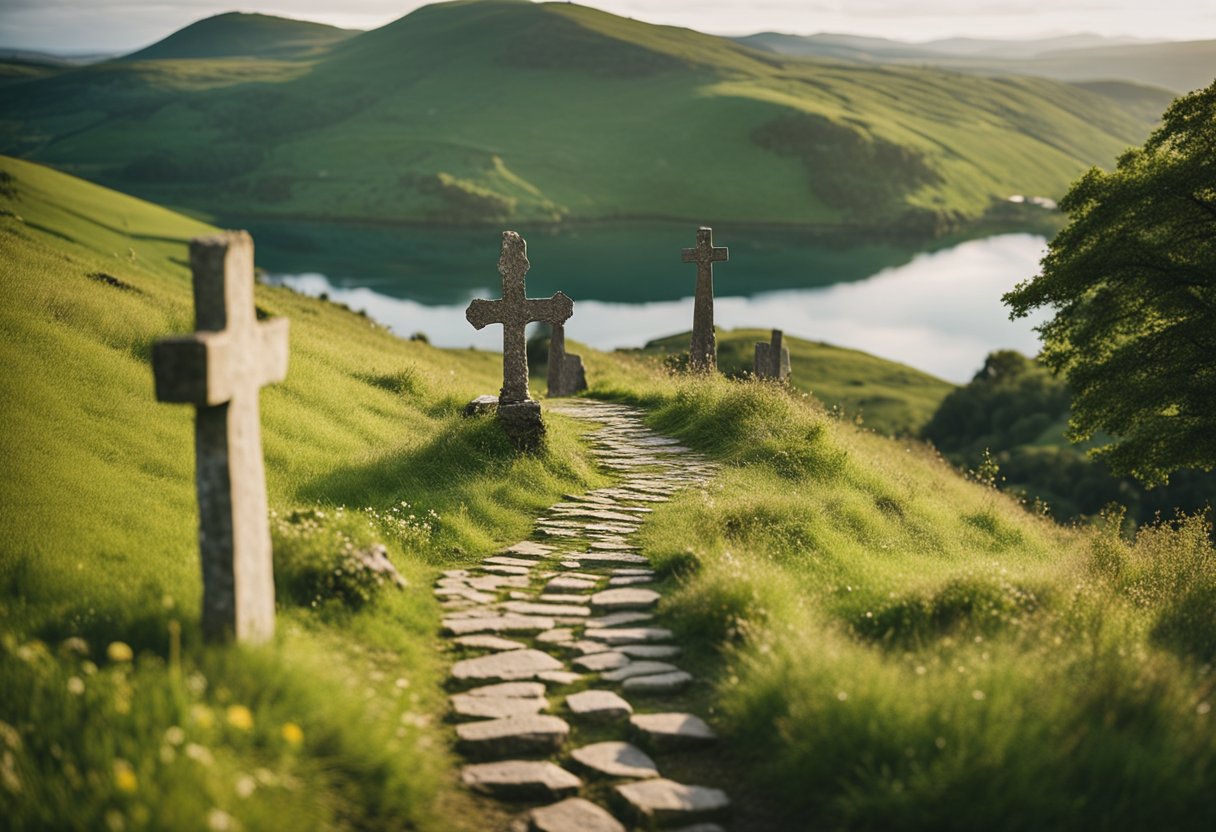
Updated On: April 15, 2024 by Maha Yassin
Ireland’s landscapes are rich with spiritual history, home to a network of ancient pilgrimage routes that today offer both an echo of the past and a contemporary journey for travellers. Each path is laden with stories, linking the footsteps of modern-day pilgrims to the centuries of seekers who have traversed these routes in pursuit of spiritual fulfilment. As we explore the variegated trails that crisscross the Emerald Isle, we find a physical path and a narrative woven into the very fabric of Ireland’s heritage.
These pilgrimage routes, offering a unique blend of natural beauty and serene landscapes, hold a place in Ireland’s historical and spiritual tapestry. Significant sites along these paths range from the legendary Croagh Patrick to the tranquil trails of St. Kevin’s Way, immersing pilgrims in a profound sense of history and reverence. As we navigate through this sense of place, the stories and practices of the past converge with the experiences of the modern pilgrim, creating a timeless journey across both the land and the soul.
Historical Context of Irish Pilgrimages
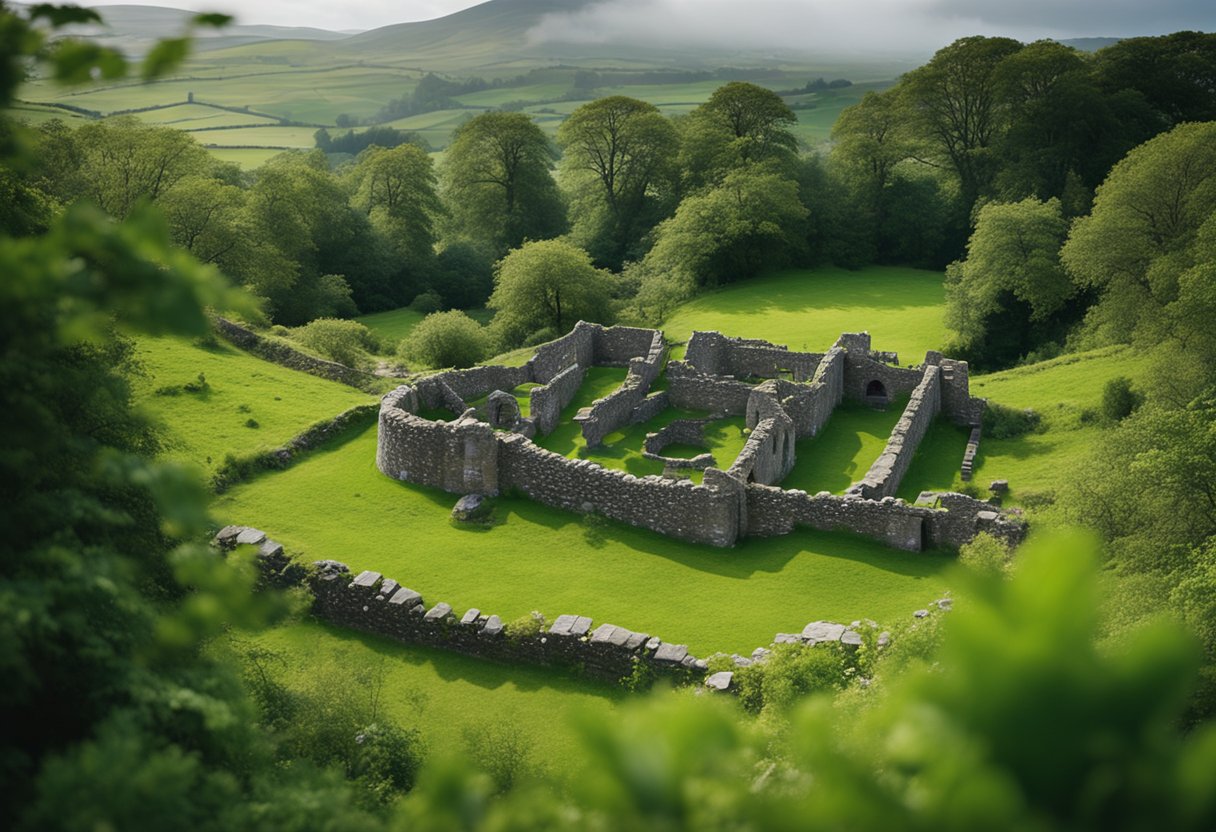
Before venturing through Ireland’s verdant landscapes and hallowed paths, one must appreciate the intertwining of Christian and Celtic traditions that gave rise to the country’s rich pilgrimage heritage. These sacred journeys, deeply embedded in Ireland’s history, offer a unique glimpse into the spiritual and religious practices of the past.
Medieval Pilgrims and Monastic Sites
Ireland became known as the “Island of Saints and Scholars” in the early Middle Ages due to the many monastic settlements proliferating nationwide. Pilgrims from various regions in Ireland and Europe would journey to renowned sites such as Clonmacnoise and Glendalough. These monastic sites were ecclesiastical powerhouses and centres of learning, manuscript production, and knowledge repositories. Medieval pilgrims would travel to these sacred places, often marked with a distinctive Celtic cross, to seek enlightenment, penance, and healing.
Celtic Spirituality and Christian Traditions
The fabric of the Irish pilgrimage is woven with threads of ancient Celtic spirituality entwined with early Christian traditions. The reverence for natural features like wells, trees, and mountains fused with Christian practices to create a distinctive spiritual landscape. This unique blend can be seen at sites like Croagh Patrick, where a tradition of penitential ascent dates back to the time when Saint Patrick spent Lent on the mountain in the 5th century, giving rise to annual pilgrimages celebrating both Ireland’s patron saint and the country’s earlier spiritual heritage.
Famous Pilgrimage Routes
Ireland’s spiritual heritage is etched into its landscape through various pilgrimage routes, each carrying unique historical and religious significance. In this section, we explore some of the country’s most renowned pilgrim paths, which attract thousands of visitors annually seeking reflection, penance, and a deeper connection with Ireland’s ancestral faith traditions.
Croagh Patrick
Often referred to as ‘The Reek’, Croagh Patrick is possibly Ireland’s most famous religious site, standing proudly over County Mayo. Legend asserts that St. Patrick, Ireland’s patron saint, fasted and prayed at the summit for 40 days. Nowadays, on the last Sunday of July, known as ‘Reek Sunday’, pilgrims ascend the mountain, with some even braving the climb barefoot, re-enacting ancient penitential practices.
Tochar Phadraig
Another ancient trail in County Mayo is Tochar Phadraig, believed to be a chariot path that converts into a Christian pilgrimage, linking Croagh Patrick to the town of Ballintubber and its 800-year-old abbey. This route spans over 30 miles and passes various historical sites, once forming part of the Royal Pilgrim Road to Croagh Patrick.
St. Kevin’s Way
St. Kevin’s Way meanders through the scenic Wicklow Mountains, immortalising the journey of St. Kevin, a revered monastic figure. This relatively tranquil path, beginning at Hollywood and spanning approximately 30 kilometres to the monastic ruins at Glendalough, offers pilgrims a spiritually resonant stroll through County Wicklow‘s picturesque and historical landscape.
St Finbarr’s Pilgrim Path
Down in County Cork, St. Finbarr’s Pilgrim Path carries onlookers through rugged terrain from Drimoleague to Gougane Barra, where the hermit St. Finbarr founded a monastery in the 6th century. This ancient route invites modern-day pilgrims to discover the serene beauty of the region while retracing the steps of the religious figures who once traversed these lands.
Significant Pilgrimage Sites

In Ireland, certain locations stand out for their spiritual significance and cultural heritage. These sites are essential to the historical narrative and the modern-day pilgrimage experience.
Glendalough
Glendalough, known for its striking valley in County Wicklow, hosts an early Christian monastic settlement founded by St. Kevin. Visitors are drawn to the ancient churches and round towers, seeking a connection to Ireland’s ecclesiastical past amidst tranquil scenery.
Lough Derg
Lough Derg in County Donegal is home to St. Patrick’s Purgatory, a unique pilgrimage site with a rigorous three-day fasting and prayer programme. The chapel on Station Island, where pilgrims partake in the traditional barefoot circuits, is the focal point of a journey intended for reflection and penance.
Ballintubber Abbey
Ballintubber Abbey in County Mayo, known as “The Abbey that refused to die,” has welcomed pilgrims since it was established in 1216. The abbey remains a living testament to Ireland’s cultural heritage, with masses held regularly, providing a continuous worship thread for over 800 years.
Skellig Michael
Skellig Michael, off the coast of County Kerry, captivates with its remote, oceanic beauty and extraordinary history. The UNESCO World Heritage Site includes well-preserved monastic remains between the 6th and 8th centuries. It is renowned for its dramatic setting and the physical challenge presented to visitors.
The Contemporary Pilgrim Experience

In recent years, the allure of pilgrimage in Ireland has been rekindled, offering a refreshing blend of spiritual experience and physical activity. Whether pursuing a personal sense of penitence or seeking a deeper connection with history and culture, the modern-day pilgrim finds a structured yet personal journey on these storied paths.
Pilgrim Paths Passport
To enhance the walking experience, we can obtain a Pilgrim Paths Passport. This booklet serves as a record of our journey, stamped at designated locations along the pilgrim paths. The concept of a passport not only incentivises our footfall—it transforms our passage into a tangible chronicle of reflection and discovery.
Local Guides and Tours
Local guides and tours offer a wealth of knowledge for those of us who prefer shared insights and camaraderie. Engaging in a guided tour allows us to immerse in the rich tapestry of Irish heritage, enveloped by the emerald charm of the landscape, making every step an enlightening episode in our spiritual quest.
Modern-Day Penitents
In our digital age, as modern-day penitents, we are rediscovering ancient practices to satiate our yearning for a respite from the hectic world. Whether we traverse these paths solo or as part of a group, our journey is often as much about internal reflection as the miles covered by foot. It’s a poignant reminder that the act of pilgrimage is a living tradition, as meaningful today as it was centuries ago.
Natural Beauty and Landscapes
Ireland’s pilgrimage routes are as much a journey through stunning vistas as they are a testament to spiritual devotion. These paths weave through some of the most breathtaking landscapes the Emerald Isle offers, where walkers can immerse themselves in the beauty of nature and gaze upon horizons that stretch for miles.
The Wicklow Mountains
The Wicklow Mountains offer a serene backdrop for our pilgrimage. Known as the ‘Garden of Ireland’, this region promises ever-changing views of rolling hills, verdant valleys, and pristine lakes. The landscape invites a sense of peace and contemplation, making it a favourite among nature enthusiasts and walkers alike. The well-trodden paths through Wicklow, such as St. Kevin’s Way, guide us through picturesque heathland and dense woodlands, a true celebration of Ireland’s natural splendour.
Shehy and Caha Mountains
Further south, we traverse the rugged terrains of the Shehy and Caha Mountains. Its stark, wild beauty defines this area, with landscapes carved by ancient glacial movements. The Shehy Mountains combine gently sloping hills and sharp peaks, while the Caha Mountains boast dramatic rocky outcrops. Pilgrims venturing here will find their resolve tested and rewarded with some of the most remarkable and expansive mountain panoramas Ireland offers.
Spiritual Significance and Practices
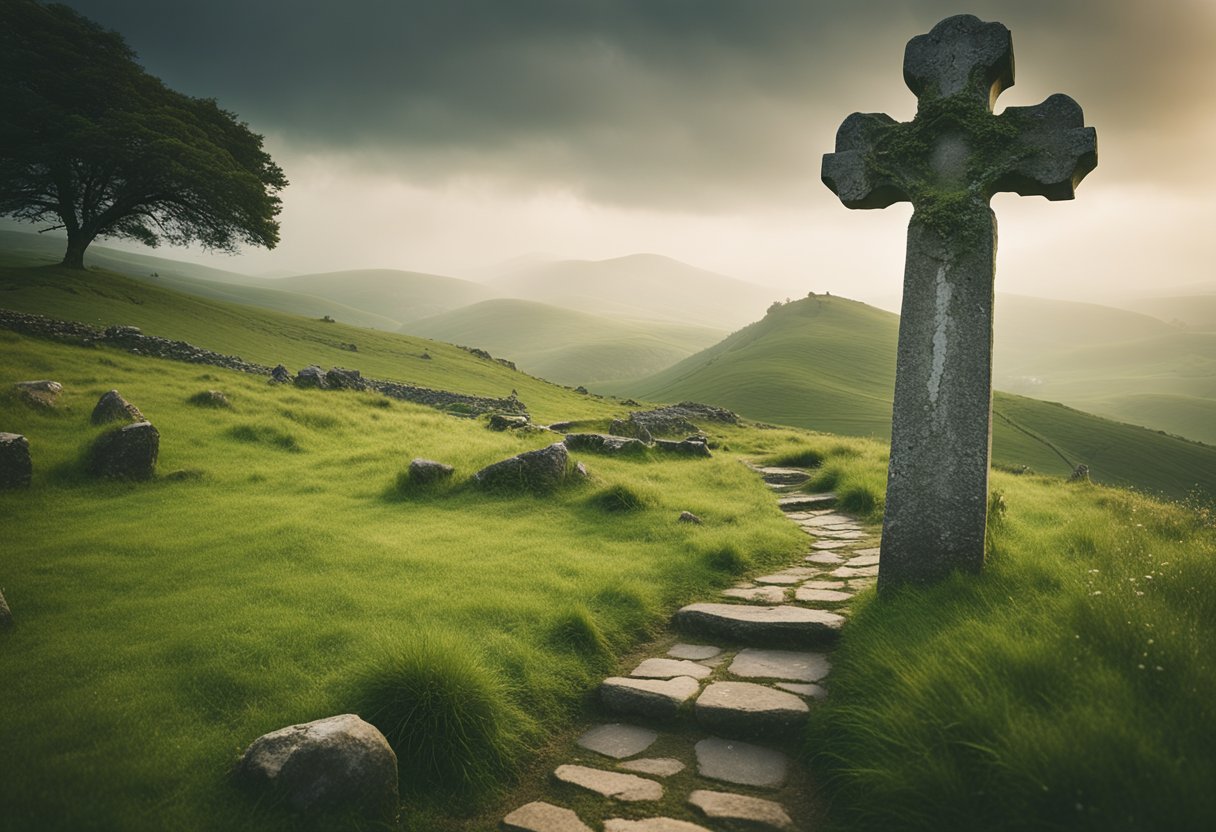
This section explores the profound spiritual significance embedded in Irish pilgrimage routes and the unique practices embodying this rich spiritual tradition.
Sacred Rituals
Embarking on a pilgrimage is often interwoven with sacred rituals denoting a journey of the body and the soul. Among the most emblematic of these is the practice of walking barefoot, a means of penance, humility, and connection to the land. Pilgrims traverse sacred paths and are encouraged by the rugged terrain to reflect inwardly, adding depth to their spiritual quest.
- Sacred Paths: Walking in humility and reflection.
- Barefoot: A symbol of penance and immersion in the journey.
Holy Wells and Water
Holy wells are a cornerstone of spiritual practice along Irish pilgrimage routes. These ancient sources of water are often ascribed healing properties and are venues for prayer and reflection. To partake in their spiritual significance, visitors may drink or anoint themselves, engaging in a timeless connection with the heritage of spirituality.
- Holy Wells: Sites for healing, prayer, and timeless traditions.
- Water: Emblem of purity and essential element in ritual practices.
Each practice and landmark along these routes, from the simple act of collecting water to the arduous journey taken by pilgrims, underscores the profound spirituality that permeates Ireland’s sacred landscapes.
Irish Pilgrimage and Global Context
This section explores the connections between Ireland’s pilgrimage traditions and the wider world of spiritual journeys, focusing on the Camino de Santiago’s influence and comparative views on global pilgrimage traditions.
Camino de Santiago Influence
The Camino de Santiago has cast a considerable shadow over pilgrimages worldwide, not least on the routes across Ireland. The concept of the Celtic Camino promotes spiritual walks in Ireland as a prelude to the more extensive exploration in Spain, grounding the Irish pilgrimage experience within a global framework. Pilgrims often start their journey in Ireland, traversing sacred pathways like Cosán na Naomh before continuing on the renowned pilgrim path to Santiago de Compostela. This synergy puts Ireland on the map as a significant starting point for one of Christianity’s most famous pilgrimages.
Comparisons with Other Pilgrimage Traditions
Ireland’s pilgrimages share commonalities with other global traditions by enriching pilgrims’ spiritual and cultural connections. Comparatively, Irish pilgrimage routes are akin to the pilgrimages to Jerusalem, Rome, and Canterbury in their blend of penitence, spiritual renewal and quest for historical continuity. The routes, narratives, and collective experiences embody a broader human inclination towards the search for meaning, a trend evident from the Middle Eastern trails to Jerusalem to the Via Francigena leading to Rome. Each tradition, whether it be the cosmopolitan spirit of the Camino de Santiago or the historical routes across Canterbury, shares in the desire to bridge the physical journey with metaphysical introspection.
Challenges to Preserving Pilgrimage Routes
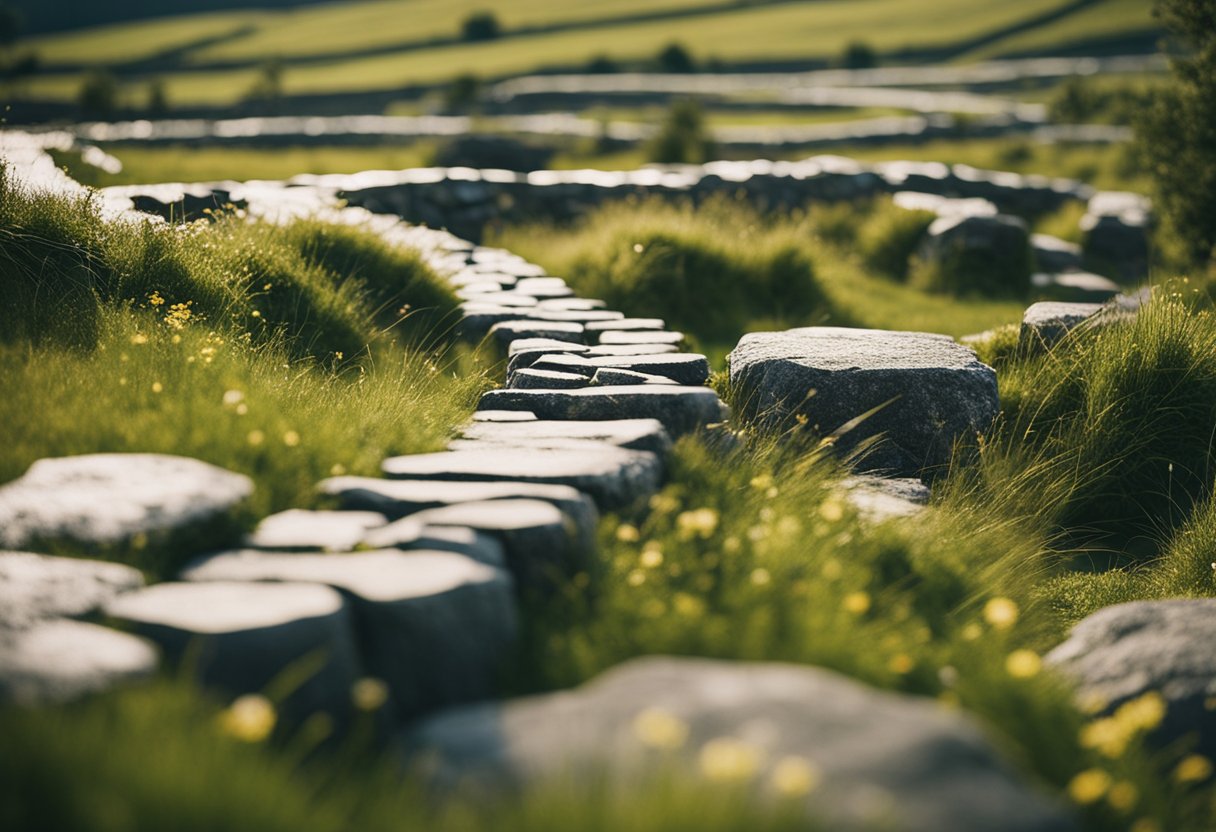
Preserving Ireland’s pilgrimage routes is crucial for maintaining these historic paths’ cultural heritage and environmental integrity. We face several specific challenges in this effort.
Environmental Impact
Irish pilgrimage routes, such as the one leading to Clonmacnoise, are delicate ecosystems. The pressure from increased foot traffic can lead to soil erosion and damage to native flora. Measures must be taken to protect the landscape while accommodating pilgrims. Signage that promotes Leave No Trace principles could educate visitors about minimal impact practices.
Cultural Heritage Preservation
As custodians of our cultural heritage, we must ensure sites like Clonmacnoise are conserved for future generations. The challenge lies in balancing accessibility with protection. Traditional pilgrimage routes could deteriorate with extensive use, losing historical context and physical structure. Strategic management of visitor numbers and regular maintenance and restoration projects funded by conservation grants are essential steps towards sustainable preservation.
Role of Pilgrimage in Modern Irish Society
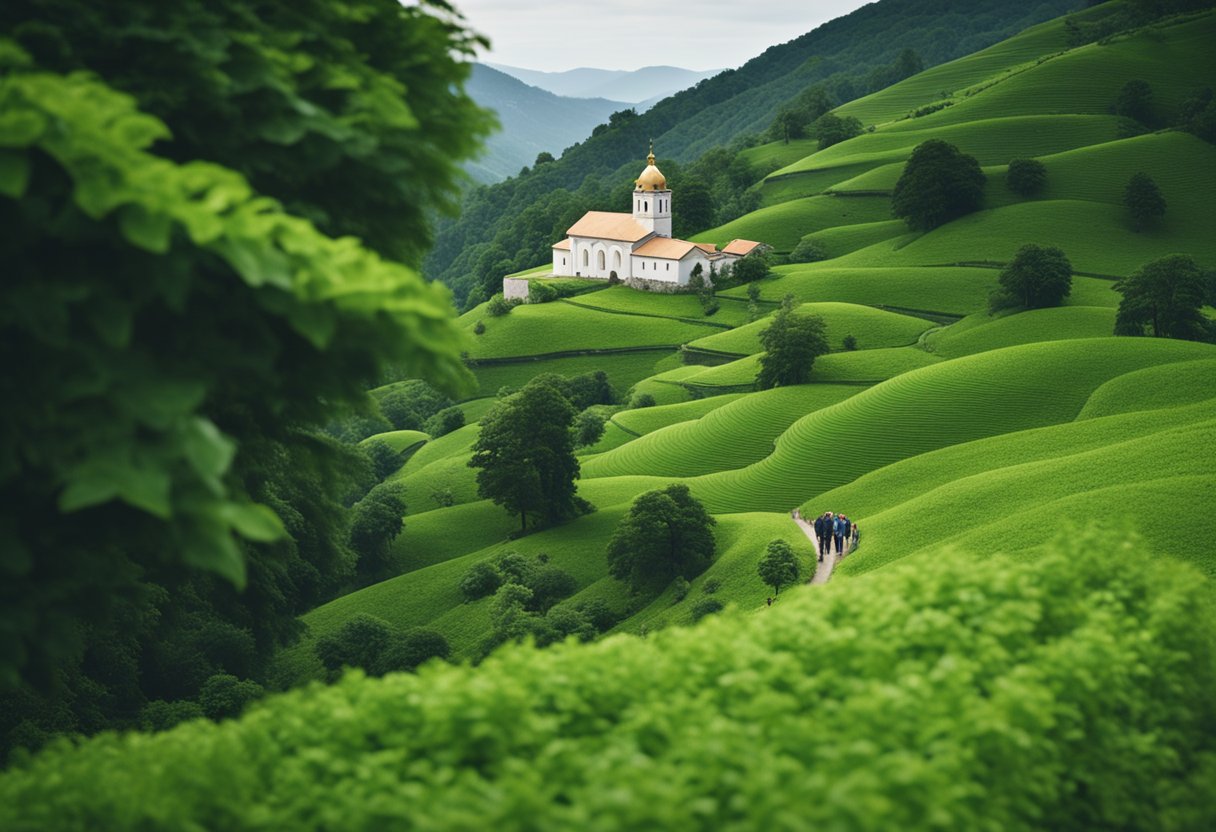
In modern Ireland, pilgrimages are a means of religious observance and play a striking role in tourism and the economy. Simultaneously, these spiritual journeys offer a bridge connecting the present to the rich tapestry of Irish history.
Tourism and Economy
Pilgrimage routes across Ireland are beacons for both domestic and international travellers eager to uncover the spiritual and historical essence of the land. Places like the Rock of Cashel, Croagh Patrick, and Glendalough stand as robust pillars of Ireland’s devout past sewn into the fabric of today’s vibrant cultural tourism. Our religious sites offer a dual opportunity: to enhance religious observance and contribute significantly to local economies. These sacred journeys provide employment, from the hospitality services catering to pilgrims to the guides who narrate the stories interwoven with each hallowed site.
Religious Observance
Beyond the economic impact, the act of pilgrimage in Ireland is a profound expression of faith and a practice that many Irish people still hold dear. Spiritual experiences gained during such pilgrimages are vastly personal and reflective, offering participants a chance to follow in the footsteps of saints and scholars from Irish history. Sites like St. Patrick’s Purgatory in Lough Derg and the Shrine of Our Lady of Knock continue to draw the faithful for moments of prayer, reflection, and a search for higher spiritual fulfilment, just as they have done for centuries past. These practices showcase the living tradition of pilgrimage in Ireland, bridging the spiritual experience to modern Irish society.
Guidelines for Pilgrims
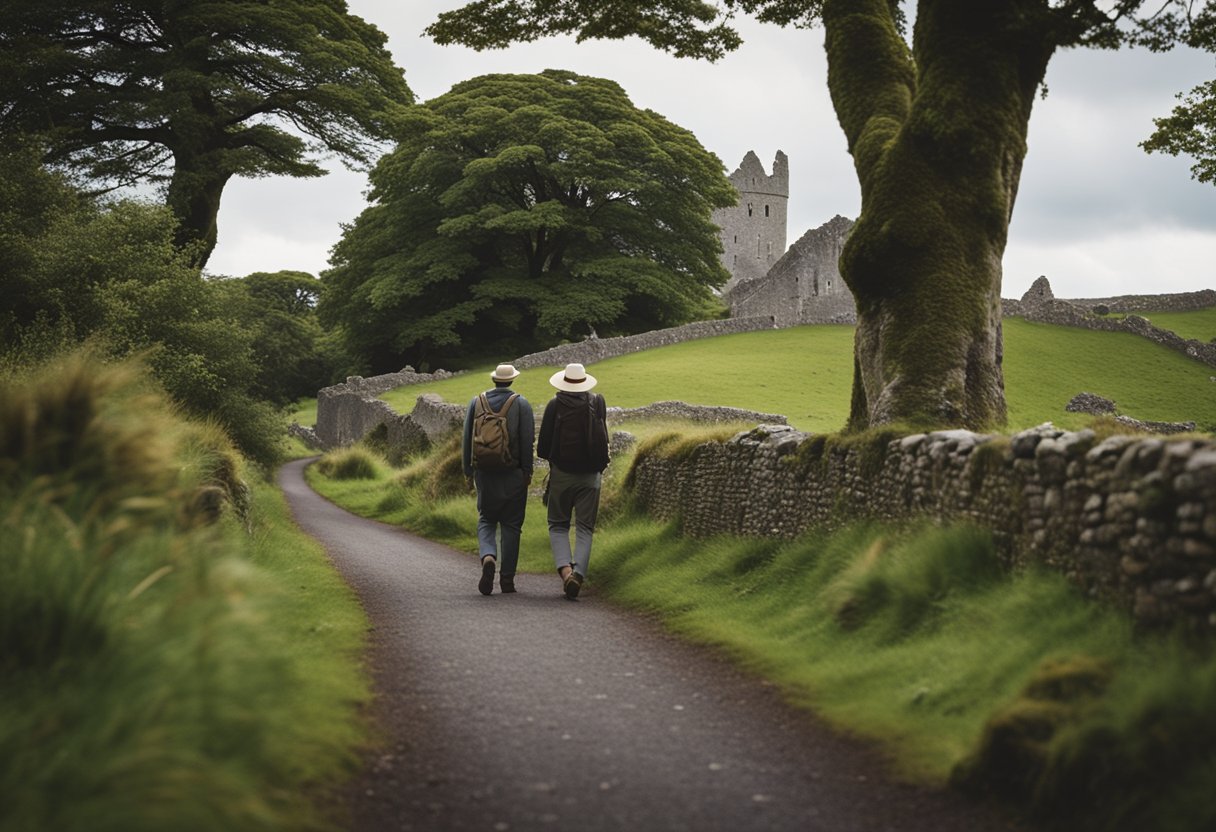
When embarking on a pilgrimage in Ireland, it’s crucial to adequately prepare and follow certain health and safety measures to ensure a fulfilling and secure experience.
Preparation and Conduct
Preparation: Every pilgrimage requires thoughtful preparation. As we plan to undertake these spiritual journeys, we must consider the following:
- Route Knowledge: Familiarise yourselves with your chosen pilgrimage route, including its length, terrain, and significant religious sites, such as well-established paths to a holy well.
- Emotional and Spiritual Readiness: Reflect on the purpose of your pilgrimage – are you seeking spiritual growth, healing, or simply the peace of walking through Ireland’s sacred landscapes?
- Equipment: Ensure you have the necessary equipment, notably trekking boots for rough terrain, weather-appropriate clothing, and a map or GPS device.
Conduct: As pilgrims, our conduct on these sacred walks reflects our respect for the tradition:
- Respect for Nature and Locals: Leave no trace of your presence and minimise your environmental impact. Show consideration to residents and fellow walkers.
- Silence and Reflection: Embrace moments of silence and reflection, allowing the spiritual significance of the pilgrimage to resonate within you.
Health and Safety
Personal Health: As pilgrims, maintaining our health during the journey is paramount. Here are some tips:
- Fitness Level: Assess your physical condition and choose a route commensurate with your fitness level. Some routes may be strenuous and require good endurance and physical health.
- Hydration and Nutrition: Carry sufficient water and snacks to maintain hydration and energy levels throughout your walk.
Safety Measures: Implementing safety measures is fundamental for any pilgrimage. Keep the following in mind:
- Emergency Plan: A clear emergency plan includes knowledge of the nearest medical facilities and means of contacting emergency services.
- Walking in Groups: If possible, walk with others. It’s safer and can enrich your experience through shared reflections and mutual support.
Future of Irish Pilgrimages
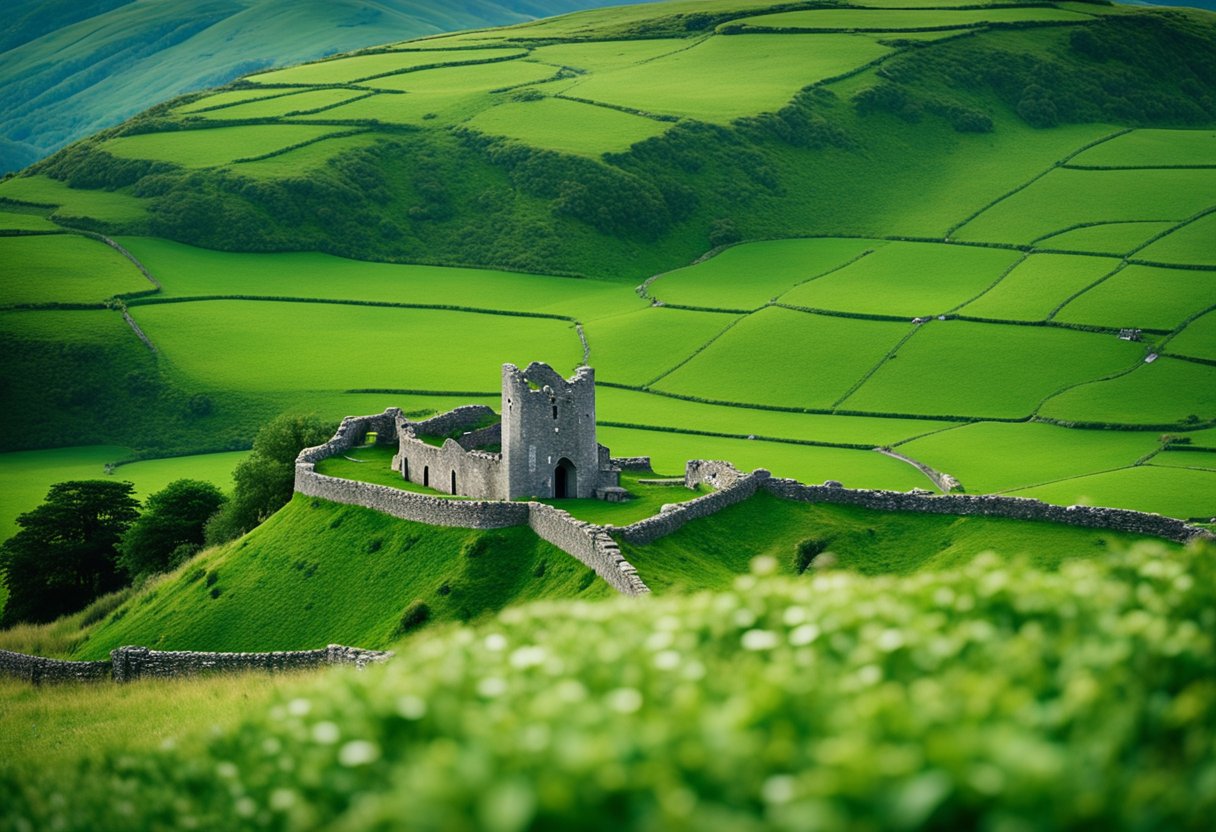
In looking ahead, the Irish pilgrimages are embracing conservation efforts and the latest advancements in the Irish Pilgrim Passport to ensure their sustainability and appeal to modern-day pilgrims.
Conservation Efforts
Ireland’s commitment to preserving its waymarked pilgrimage routes is evident through ongoing conservation efforts. Deeply rooted in Irish cultural heritage, these routes are receiving increasing attention to protect their integrity and natural beauty. Measures include environmentally sensitive maintenance of trails and promoting responsible tourism to minimise impact on these historically significant pathways.
Irish Pilgrim Passport Advancements
The Irish Pilgrim Passport has become a celebrated aspect of experiencing Irish pilgrim paths. Efforts are underway to enhance the passport experience with digital tracking and interactive features. This enables pilgrims to document their journeys more efficiently while accessing rich historical content about their sites. Such advancements aim to enrich the spiritual and cultural journey for those exploring Ireland’s sacred trails.
Frequently Asked Questions
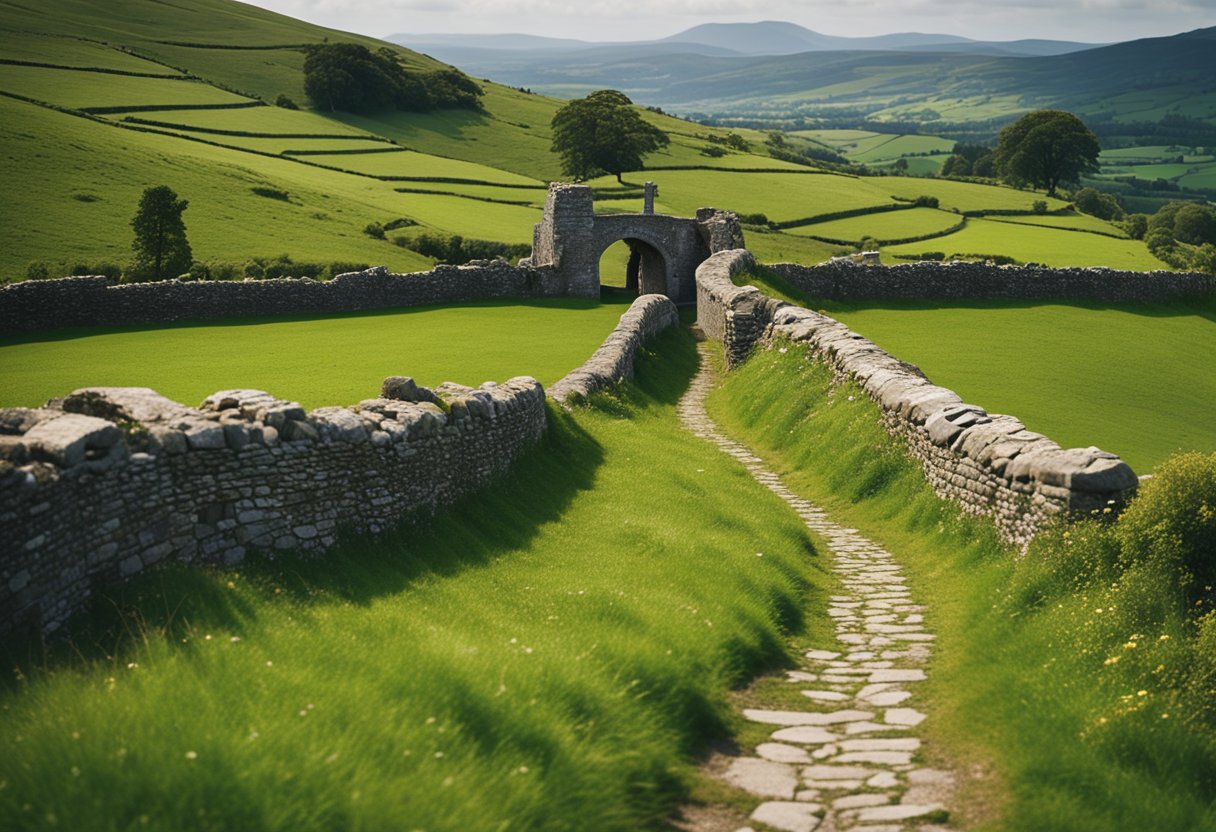
This section addresses some of the most common inquiries about Ireland’s rich tapestry of pilgrim paths, delving into their historical significance and cultural importance.
What are the historical origins of pilgrim paths in Ireland?
Ireland’s pilgrim paths date back to the early Christian period when such routes were established as conduits for spiritual journeys. These paths are interwoven with the stories of Irish saints and scholars and have been traversed by pilgrims seeking spiritual solace for centuries.
Which are the most significant pilgrimage sites in Ireland?
Significant pilgrimage sites in Ireland include the majestic Croagh Patrick in County Mayo, where St. Patrick is said to have fasted for 40 days, and St. Finbarr’s Way in County Cork that culminates at Gougane Barra, a serene lakeside hermitage. Additionally, the scenic St. Kevin’s Way in Glendalough, Co. Wicklow, is steeped in the legacy of one of Ireland’s most revered saints.
Could you detail the journey and stories associated with the Glendalough pilgrimage?
The Glendalough pilgrimage is a journey that retraces the footsteps of St. Kevin through the tranquil valley of Glendalough, marked by serene lakes and ancient monastic ruins. This path isn’t merely a walk through nature but a passage through a story of solitude, spirituality, and endurance that characterises the life of St. Kevin and the monastic community he established.
How does pilgrimage play a role in Irish cultural and spiritual life?
Pilgrimage is deeply ingrained in Irish culture, typifying a blend of spiritual reverence and community. These journeys offer an opportunity for personal reflection and penance and communal gatherings reaffirming cultural bonds and shared traditions.
Are there any pilgrimage routes in Ireland akin to the Camino de Santiago?
The Tochar Phádraig, or St. Patrick’s Causeway, parallels the Camino de Santiago, as it has been a vital Christian pilgrim path for centuries. Ireland’s pilgrim paths, including the modern Killeshandra Camino, echo the contemplative and historical essence of the Camino’s tradition.
What are some unique traditions or customs observed on Irish pilgrim paths?
Irish pilgrim paths are known for unique traditions such as ‘station’ prayers at specific holy places, fasting, and sometimes making the journey barefoot as an act of penance. On Croagh Patrick, Reek Sunday sees thousands ascending in homage to St. Patrick, maintaining the ritualistic aspect that’s been a part of this pilgrimage for generations.






